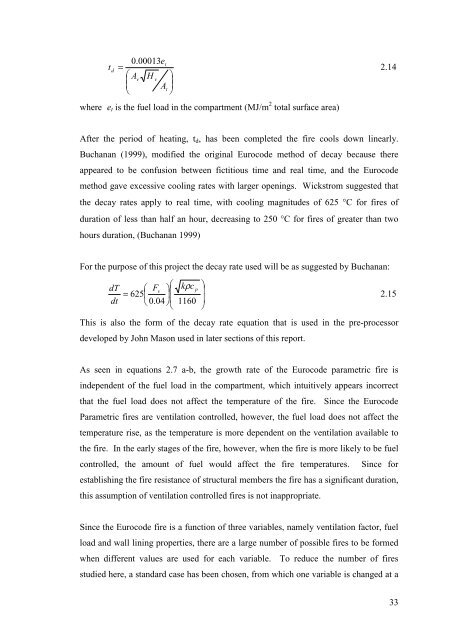FIRE DESIGN OF STEEL MEMBERS - Civil and Natural Resources ...
FIRE DESIGN OF STEEL MEMBERS - Civil and Natural Resources ...
FIRE DESIGN OF STEEL MEMBERS - Civil and Natural Resources ...
Create successful ePaper yourself
Turn your PDF publications into a flip-book with our unique Google optimized e-Paper software.
t<br />
d<br />
0.00013et<br />
=<br />
A <br />
<br />
v<br />
H<br />
v<br />
<br />
A<br />
t<br />
<br />
where e t is the fuel load in the compartment (MJ/m 2 total surface area)<br />
2.14<br />
After the period of heating, t d , has been completed the fire cools down linearly.<br />
Buchanan (1999), modified the original Eurocode method of decay because there<br />
appeared to be confusion between fictitious time <strong>and</strong> real time, <strong>and</strong> the Eurocode<br />
method gave excessive cooling rates with larger openings. Wickstrom suggested that<br />
the decay rates apply to real time, with cooling magnitudes of 625 °C for fires of<br />
duration of less than half an hour, decreasing to 250 °C for fires of greater than two<br />
hours duration, (Buchanan 1999)<br />
For the purpose of this project the decay rate used will be as suggested by Buchanan:<br />
dT F <br />
kρc<br />
v<br />
= 625<br />
<br />
<br />
p<br />
dt 0.04 <br />
1160<br />
<br />
<br />
<br />
<br />
<br />
This is also the form of the decay rate equation that is used in the pre-processor<br />
developed by John Mason used in later sections of this report.<br />
2.15<br />
As seen in equations 2.7 a-b, the growth rate of the Eurocode parametric fire is<br />
independent of the fuel load in the compartment, which intuitively appears incorrect<br />
that the fuel load does not affect the temperature of the fire. Since the Eurocode<br />
Parametric fires are ventilation controlled, however, the fuel load does not affect the<br />
temperature rise, as the temperature is more dependent on the ventilation available to<br />
the fire. In the early stages of the fire, however, when the fire is more likely to be fuel<br />
controlled, the amount of fuel would affect the fire temperatures. Since for<br />
establishing the fire resistance of structural members the fire has a significant duration,<br />
this assumption of ventilation controlled fires is not inappropriate.<br />
Since the Eurocode fire is a function of three variables, namely ventilation factor, fuel<br />
load <strong>and</strong> wall lining properties, there are a large number of possible fires to be formed<br />
when different values are used for each variable. To reduce the number of fires<br />
studied here, a st<strong>and</strong>ard case has been chosen, from which one variable is changed at a<br />
33
















